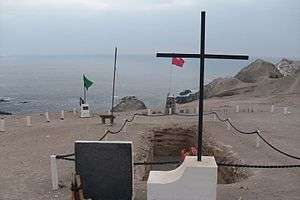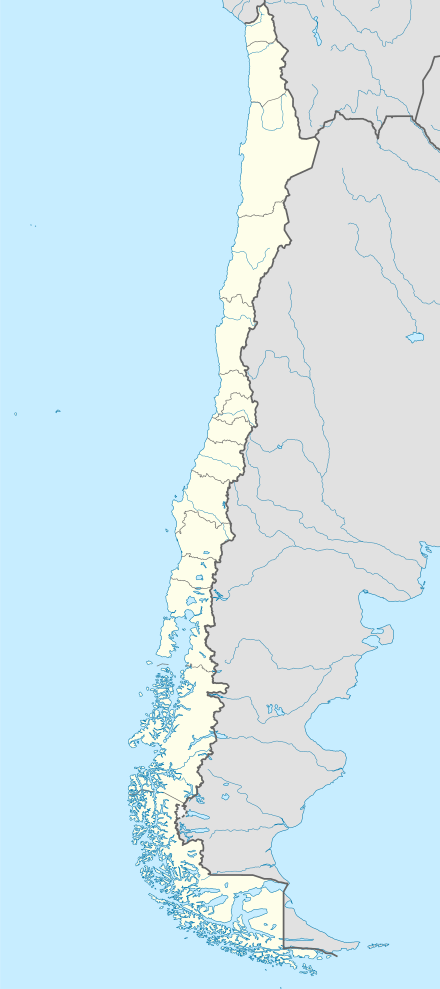Pisagua internment camp
| Pisagua internment camp | |
|---|---|
| Internment camp used many times in Chilean history | |
 The Pisagua Memorial in 2007 | |
 Location of Pisagua internment camp within Chile | |
| Coordinates | 19°35′48″S 70°12′44″W / 19.59667°S 70.21222°WCoordinates: 19°35′48″S 70°12′44″W / 19.59667°S 70.21222°W |
| Location | Pisagua |
| Built by | Chilean government |
| Operated by | Chilean government |
| Operational |
1927-1931 1939-1947 1973-1974 |
| Number of inmates | 2500 people (during the 1973-1974 biennium) |
| Killed | 30 people (during the 1973-1974 biennium) |
The Pisagua internment camp (Spanish: Campamento de Prisioneros de Pisagua) was a concentration camp in Pisagua, Chile.
History
An isolated location in northern Chile, Pisagua was used as a detention site for male homosexuals under the military dictatorship of General Carlos Ibáñez del Campo in 1927-1931.[1]
From 1943 to 1945, Pisagua became the site of wartime internment for citizens of enemy nations when Chile entered World War II on the Allied side. The complex was turned into a concentration camp for Chilean socialists, communists and anarchists under President Gabriel González Videla in 1947-1948. Chilean Army Captain Augusto Pinochet was appointed to run the Pisagua camp in January 1948.
Pinochet's dictatorship to present
When General Pinochet himself seized power in September 1973, the site again became a political detention center.
In the 1990s, the Pisagua court case would draw further scrutiny to the prison camp when a claim of illegal burial was presented by the Chilean Vicariate of Solidarity on 31 May 1990.[2] A mass grave was discovered in June 1990 and was found to contain 20 bodies inside.[3] These would be later linked to prisoners and missing persons (desaparecidos) executed at the camp.
Identified persons from mass grave (June 6, 1990)
| Order of Discovery[3] | Name[3] |
|---|---|
| 1 | Manuel Eduardo Sanhueza Mellado |
| 2 | Nicolas Chanez Chanez |
| 3 | Tomas Orlando Cabello Cabello |
| 4 | Luis Manriquez Wilde |
| 5 | Juan Orlando Rojas Osega |
| 6 | Hugo Tomas Martinez Guillen |
| 7 | Alberto Amador Yañez Carvajal |
| 8 | Luis Alberto Toro Castillo |
| 9 | Nelson Jose Marquez Agusto |
| 10 | German Elidio Palominos Lamas |
| 11 | Juan Apolinario Mamani Garcia |
| 12 | Jose Rufino Cordova Croxatto |
| 13 | Juan Valencia Hinojosa |
| 14 | Julio Cesar Cabezas Gacitua |
| 15 | Mario Morris Barrios |
| 16 | Humberto Lizardo Flores |
| 17 | Luis Alberto Lizardi Lizardi |
| 18 | Marcelo Omar Guzman Fuentes |
| 19 | Juan Efrain Calderon Villalon |
| 20 | *Not confirmed by source |
See also
Footnotes
- ↑ Spooner 2011, p. 58
- ↑ "El Hallazgo de la Fosa". Memoria Viva. Archived from the original on 16 June 2002. Retrieved 4 July 2012. (in Spanish)
- 1 2 3 "Plano de la fosa común en el cementerio de Pisagua". Memoria Viva. Archived from the original on 5 June 2010. Retrieved 10 May 2013. (in Spanish)
References
- Frazier, Lessie Jo (2007). Salt in the Sand: Memory, Violence, and the Nation-State in Chile, 1890 to the Present. Durham, North Carolina: Duke University Press. ISBN 0-822-34003-8. External link in
|title=(help) - Spooner, Mary Helen (2011). The General's Slow Retreat: Chile After Pinochet. Berkeley and Los Angeles: University of California Press. ISBN 978-0-520-25613-2. External link in
|title=(help)